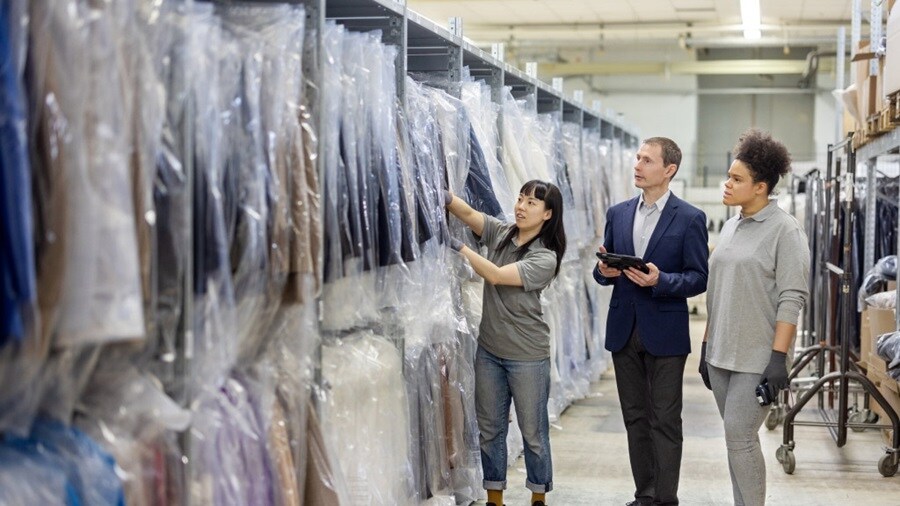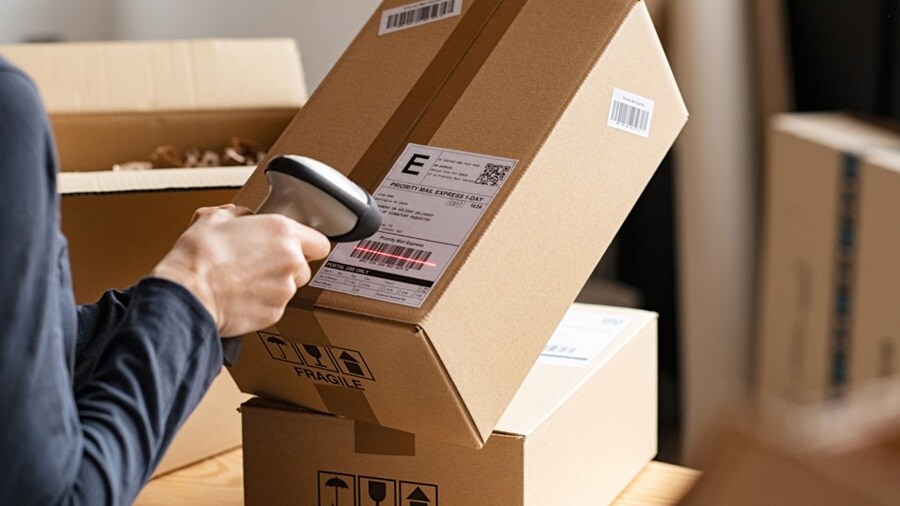Discover how your supply chain can adapt to the surge in online shopping.
While retailers have been tempering their growth expectations in light of ongoing global economic uncertainty, online retail growth projections continue to follow a positive trajectory.

Europe is leading the charge, according to data from ECBD1. While global e-commerce is expected to reach 49.1% user penetration by 2029, some major European economies are forecast to reach penetration rates far higher than this, exceeding 80% in some cases.
Fashion and retail verticals are performing particularly well. Fashion was Europe’s best selling e-commerce category in 2024, with $149bn revenue2. Buying goods from nearby European countries is also common among Europe’s largest e-commerce markets, with consumers sourcing a large proportion of their online purchases from suppliers outside of their national borders in Italy (80%), Spain (46%) and Germany (43%).
But continued demand brings its own challenges, particularly as the highly competitive e-commerce space is seeing increasingly high service expectations from consumers. For example, next-day and same-day delivery were considered premium services only a few years ago but are now becoming the standard expectation. How can businesses adapt their inventory management and fulfilment strategies so they can continue to meet these demands?
How are brands responding?
Perhaps unsurprisingly, AI is having a dramatic impact on how consumers across Europe shop online. Fashion and product trend forecasting, as well as the opportunity for retailers to provide shoppers with greater personalisation, are among the emerging features of a modern, European digital shopping experience.

This shift to personalisation will likely require an adjustment to warehousing and logistics strategies for retailers, who need to be able to manage a greater variety of SKUs whilst efficiently fulfilling e-commerce orders for consumers who expect same or next day delivery – demands that are likely to keep rising. Suppose trends in Europe follow that of China, where the one-hour delivery promise is common among e-commerce giants, dropping to as little as 30 minutes for fierce competitors like Alibaba’s grocery chain Hema. If that happens, structural resilience will become even more important. Hinging on strategically located warehouses that ensure a strong regional presence, with facilities capable of receiving, storing and processing cargo quickly and flexibly.
Among the most revolutionary innovations are taking place in how businesses are using AI to predict and manage supply and demand. H&M has started hiring data scientists to track purchase patterns and changes in demand, while Zara3 has implemented AI algorithms to help predict spikes in popularity so they can adjust inventory and optimise their product development around popular designs and colours.
The correct digital infrastructure is required across key parts of the supply chain to ensure this level of insight leads to commercial results. In the case of retailers like Zara4, real-time inventory tracking and demand forecasting triggers automated restocking requests in stores, and redistribution between warehouses to ensure appropriate SKU volumes in the right places for efficient fulfilment.
Some brands are even integrating more technology into their garments, such as Nike’s Adapt BB ‘self-lacing’ basketball shoes5. Integrated RFID tags are becoming more common6 during the manufacturing process to track items through production and purchase, providing data on a product’s provenance.
This adds further complications for retailers that put sustainability front and centre of their commercial strategy and brand, as continually redistributing goods between warehouses will increase the overall carbon footprint of individual products. From a warehousing perspective, this raises questions about whether there should be a ‘limit’ on the number of times a product moves around before it is sold.
Adapting your warehousing strategy for new retail trends

Anticipating demand and adjusting fulfilment strategies is just one part of adapting to changing consumer expectations. Businesses must also consider how to maintain their supply of goods to match the growth in online purchases.
Consumer goods is Europe’s third-largest manufacturing segment, and disruptions can put pressure on meeting demand as well as profit margins. Sourcing and supply issues continue to be a major problem for many European firms, with 88% of FMCG manufacturers in the EU reporting challenges in the last year, according to Aim’s European Consumer Goods Industry Barometer7.
This has been a particular sticking point for dairy companies like Danone8, who have had to make changes to their regional sourcing practices to maintain market share where consumers are increasingly seeing local producers as more trustworthy. This isn’t just a brand issue for Danone. They have had to carefully scale up sourcing capacity where large-scale production capability in regions where this may not yet exist.
For non-perishables, the solution is perhaps a little easier to manage. Stockpiling remains a cost-effective solution in Europe – for example, locations such as Romania are significantly closer than China, enabling customers to maintain short inland and last-mile fulfilment than shipping ordered goods from Asia to maintain supply during spikes in demand.
But stockpiling on its own may not work for some businesses, who are seeing significant geographical diversification of their customer base. This has left many businesses considering diversifying their warehouses across Europe to better facilitate fulfilment in line with online shopping trends.
Partnering with Maersk provides access to a network of strategically located warehouses across Europe. We have the storage and fulfilment expertise and can also support with seasonal peaks and overstocking. Find out more about our contract logistics services.
Better still, our ability to connect with other services further strengthens your regional supply chain. Our vast inland network makes it easy to balance inventory across different regions, and ensure that perishables can quickly reach customers, helping you to manage cargo movements end-to-end, quickly and efficiently. Find out more about Maersk’s inland services.
Whether it's a digital transformation in your logistics operations or changing your manufacturing processes to integrate smart tech into goods, making these changes a reality can be challenging without a resilient, adaptable supply chain infrastructure. Through Maersk’s network of European fulfilment centres, regional hubs and bonded warehouses, customers can enhance the flexibility and resilience of their inventory and distribution operations, including full truckload (FTL), less-than-full truckload (LTL), and parcel delivery. We can also support with quality control, re-packing and labelling/tagging.
Maersk supports with specialised solutions such as bonded storage facilities and omnichannel fulfilment centres that can easily be connected up with other Maersk supply chain services, such as inland transport and customs clearance services. Find out more about how Maersk can help you to receive, store, process and dispatch cargo quickly.
Get in touch to find out how Maersk can support your growing warehousing needs.
For more on how to optimise supply and demand with smarter warehousing choices explore our companion article here.
- https://ecdb.com/blog/european-ecommerce-market-worth-us-1-1-trillion-by-2026/3982
- ECDB_eCommerce-in-Europe-2025.pdf
- AI-Powered Fashion: How Tech is Reshaping the Future of Zara’s Fashion Empire
- https://redresscompliance.com/case-study-zaras-use-of-ai-to-stay-competitive-in-fast-fashion/
- https://www.nike.com/a/nike-adapt-bb-release-info?ref=techpacker.com
- https://techpacker.com/blog/design/iot-redefining-the-future-of-fashion/
- https://aim.be/publication/the-european-consumer-goods-barometer-2024
- The challenge that artisanal and local products represent for FMCG food and beverage companies in Europe
Get in touch with us
Interested in finding out how Maersk Contract Logistics can give your business a strategic advantage? Leave your details below and we’ll get back to you shortly.
Thank you for reaching out!
We’ll get in touch with you shortly.
Please be aware that if you’re new to Maersk, you’ll first receive an email to verify your information before we can reach out.
If you want easy access to our products and services, you can also create an account here:
We're sorry, but there was a problem sending your contact request.
Please review the form fields and ensure all required information is provided correctly. If the issue persists, please contact our support team for further assistance.
Get in touch with us
Interested in finding out how Maersk Contract Logistics can give your business a strategic advantage? Leave your details below and we’ll get back to you shortly.
Anything you need, we’re here to help
I agree to receive logistics related news and marketing updates by email, phone, messaging services (e.g. WhatsApp) and other digital platforms, including but not limited to social media (e.g., LinkedIn) from A. P. Moller-Maersk and its affiliated companies (see latest company overview). I understand that I can opt out of such Maersk communications at any time by clicking the unsubscribe link. To see how we use your personal data, please read our Privacy Notification.
By completing this form, you confirm that you agree to the use of your personal data by Maersk as described in our Privacy Notification.
